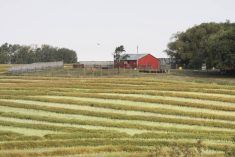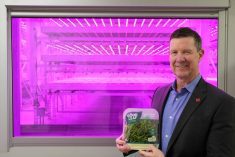RICHARDSON, Sask. — Grade 4 students are running around Richardson’s Bennett Farm shaking little vials.
Even as the students from Regina’s Lakeview School move from one learning station to another, their arms go up and down.
It’s one of the more popular ways they are learning about where their food comes from, said Susan Jorgensen, Agriculture in the Classroom-Saskatchewan programs manager.
The vials contain cream and with some vigorous shaking the cream soon becomes butter.
“We actually do that in the classroom a lot and kids are amazed at how simple it is to make butter,” Jorgensen said of the activity.
Read Also

Nutritious pork packed with vitamins, essential minerals
Recipes for pork
The visit to the farm just outside of Regina is the latest in a co-operative effort by AITC and the grain company Richardson to connect children to agriculture.
“Kids kind of have the impression that food either comes from the grocery store or the fridge,” Jorgensen said.
On this day, the children are petting horses, goats and cattle, learning how to crush canola seeds into oil, donning safety gear for use with chemical applications and posing for pictures on a tractor.
At one point, they get a crash course in manure and its uses.
The personal connection they gain from an experience like this won’t soon be forgotten, Jorgensen said.
“They really get the idea that food comes from the land and that there’s people that are involved in producing that food, and that they care about the land and the animals,” she said.
Denise Coghill, a dairy farmer from McLean, Sask., is the keeper of the cream and the vials. She said it’s always a popular activity because the students get to take something home.
The students, which also included classes from White City and Indian Head, also planted sunflower seeds to take home for microgreens.
It’s all part of AITC’s Ag Adventure program, geared toward hands-on learning and to fit parts of the Grade 4 science and social studies curricula.
One teacher said even students from rural communities actually know little about agriculture. Jorgensen said there are a variety of reasons for that, including the changing face of rural Saskatchewan.
“We’re finding with the changing population in Saskatchewan there’s a lot more of an international community in rural areas,” she explained.
Days like this are a chance for newcomers to learn about Canadian agriculture and talk about farming in their home countries. For rural schools, it allows the farm kids to take the lead and talk about what they know.
AITC also offers numerous other learning opportunities.
At Richardson’s Bennett Farm, construction is underway on a new regional office that will include a classroom-style space that AITC might be able to use in the future.
This Ag Adventure was the second to be held at the farm. Last fall, a session on food security and Saskatchewan’s role was held for older students.
Bryce Geddes, marketing specialist for Richardson Pioneer, was helping students crush canola seeds and talking to them about uses for the oil and meal.
“It’s great to provide kids the opportunity to learn about agriculture,” he said. “When they walk into their local grocery store, they have a better understanding of where things come from.”


















